The optical marketplace is an online platform where individuals or businesses can buy and sell optical products, such as eyeglasses, contact lenses, sunglasses, optical or ophthalmologic equipment. These eCommerce marketplaces are dedicated to connect buyers and sellers, providing a wide range of options at competitive prices. In this post, we’ll examine how you can build your own vision marketplace. But let’s first understand whether it is worth starting?
Optical Marketplace Statistics and Trends
The optical eCommerce industry gained traction. Here are the latest stats and trends about the industry available now:
- Global Eyewear Market Size: The global optical market was valued at around 131 billion in 2020 and is expected to reach approximately 196 billion by 2026, with a compound annual growth rate (CAGR) of 6.4% during the forecast period.
- Online Eyewear Sales Growth: The online sales of eyewear have been experiencing significant growth. In 2020, online eyewear sales accounted for around 15% of the total eyewear market, and this share is expected to increase to over 20% by 2025.
- Increasing Demand for Prescription Eyewear: With the rising prevalence of vision problems, there is a growing demand for prescription eyewear. According to the World Health Organization (WHO), around 2.2 billion people globally suffer from vision impairment or blindness, driving the need for corrective eyewear.
- Shift towards eCommerce: The optical industry has witnessed a shift towards eCommerce platforms. Consumers are increasingly turning to online marketplaces to purchase eyewear due to convenience, wider product selection, competitive pricing, and the ability to try on eyewear virtually.
- Growing Popularity of Direct-to-Consumer (DTC) Brands: Direct-to-consumer eyewear brands have gained popularity in recent years. These brands cut out the middleman and offer affordable and fashionable eyewear directly to consumers. They often leverage online marketplaces to reach a wider audience.
- Technological Advancements: Technological advancements, such as virtual try-on tools, 3D printing, and augmented reality (AR) applications, have enhanced the way people shop online for eyewear. These technologies allow customers to visualize how glasses will look on their face and make more informed purchasing decisions.
- Sustainability and Ethical Practices: There is an increasing focus on sustainability and ethical practices in the optical industry. Consumers are seeking eco-friendly eyewear options made from recycled materials, as well as brands that prioritize fair trade and ethical manufacturing processes.
The lens marketplace industry is worth undertaking. To build your optical marketplace, ensure you include the most part of trends. This will help you to outwit competitors and provide the best online shopping experience. In the context of ecommerce for online opticians, here are some key aspects of consumer behavior in the optical marketplace:
eCommerce vs. Traditional Retail in Optics
| ECOMMERCE OPTICS | vs | TRADITIONAL OPTICS |
| Convenience | ||
| Shopping from anywhere anytime | In-store visit during opening hours | |
| Product Selection | ||
| Wide | Limited shelf space | |
| Try-on | ||
| Virtual | Physical | |
| Expert assistance | ||
| Online customer support | Expert guidance in store | |
| Pricing | ||
| Lower | Higher (due to operational costs) | |
| Delivery | ||
| Delivered at doorstep | Waiting for order | |
| After-sales service | ||
| Online service with longer turnaround | In person service with in-store help |
The optical industry has seen a significant shift in consumer behavior with the rise of eCommerce. Let’s see what some key points to consider when comparing eCommerce and traditional retail in optics:
- Convenience: eCommerce offers the convenience of shopping for eyewear from anywhere, anytime. Consumers can browse through a wide range of products, compare prices, and make purchases with just a few clicks. On the other hand, traditional retail requires consumers to visit physical stores during operating hours, which may be less convenient for some.
- Product Selection: eCommerce platforms typically offer a wider selection of eyewear, including consumer optical products online, compared to traditional retail stores. Online retailers can showcase a larger inventory of frames, styles, and brands, catering to a broader range of consumer preferences. In contrast, traditional retail stores may have limited shelf space, restricting the variety of eyewear options available.
- Try-On Experience: One advantage of traditional retail is the ability to try on eyewear before making a purchase. In-store, consumers can physically try on frames, assess fit, comfort, and style. This hands-on experience allows for a more personalized decision-making process. However, some eCommerce platforms now offer virtual try-on features, allowing consumers to upload a photo and virtually try on frames, bridging the gap between the two options.
- Expert Assistance: Traditional retail stores often provide the expertise of trained opticians who can guide consumers in selecting the right frames and lenses based on their prescription, face shape, and lifestyle. In eCommerce, this assistance is typically limited to online customer support or chatbots, which may not provide the same level of personalized guidance.
- Pricing and Discounts: eCommerce platforms often offer competitive pricing due to lower overhead costs compared to traditional retail stores. Online retailers can pass on these savings to consumers, making eyewear more affordable. Additionally, eCommerce platforms frequently offer discounts, promotions, and coupon codes, further incentivizing online purchases.
- Speed of Delivery: eCommerce platforms have improved their logistics and delivery networks, allowing for faster shipping times. Consumers can receive their eyewear directly at their doorstep within a few days. In contrast, traditional retail may require consumers to wait for their eyewear to be ordered or processed, which can take longer.
- After-Sales Service: Traditional retail stores often provide in-person after-sales service, including adjustments, repairs, and replacements. Consumers can visit the store for any issues or concerns with their eyewear. eCommerce platforms typically offer customer service channels for such matters, but the process may involve shipping the eyewear back and forth, resulting in longer turnaround times.
Both eCommerce and traditional retail have their own advantages and limitations in the optical industry. The choice between the two ultimately depends on individual preferences, needs, and priorities.
Consumer Behavior in the Optical Marketplace
Understanding consumer behavior in the optical marketplace helps eyewear manufacturers, retailers, and eye care professionals tailor their products and services to meet consumer needs and preferences. It also helps in developing effective marketing strategies and provides a positive customer experience. Here are some key aspects of consumer behavior in the optical marketplace:

- Need for Vision Correction: The primary driver of consumer behavior in the optical marketplace is the need for vision correction. Consumers seek eyewear solutions to address refractive errors such as nearsightedness, farsightedness, astigmatism, and presbyopia. The type of eyewear chosen (eyeglasses, contact lenses, etc.) depends on personal preferences, lifestyle, and comfort.
- Fashion and Style: Eyewear has become a fashion statement, and consumers often consider the aesthetics and style of frames when making a purchase. Eyeglasses are seen as a fashion accessory, and consumers look for frames that complement their personal style and enhance their appearance. Trends in frame designs, colors, and materials influence consumer choices.
- Brand Reputation and Trust: Consumers often consider the reputation and trustworthiness of eyewear brands when making a purchase decision. Established brands with a history of quality and customer satisfaction are more likely to attract consumers. Positive reviews, recommendations from friends or family, and word-of-mouth marketing also play a role in shaping consumer behavior.
- Price and Value: Price is a significant factor for many consumers when purchasing eyewear. Consumers seek value for their money and compare prices across different brands and retailers. While some consumers may prioritize affordability, others may be willing to pay a premium for high quality, innovative features, or designer brands.
- Convenience and Accessibility: Consumers value convenience and accessibility when it comes to purchasing eyewear. Online shopping has gained popularity, offering consumers the convenience of browsing and purchasing eyewear from the comfort of their homes. Additionally, factors such as the availability of nearby optical stores, ease of scheduling eye exams, and efficient customer service influence consumer behavior.
- Health and Safety Considerations: Consumers are increasingly concerned about the health and safety aspects of eyewear. They look for products that provide adequate UV protection, blue light filtering, and impact resistance. Consumers may also prioritize eyewear options that are hypoallergenic, lightweight, and comfortable to wear for extended periods.
- Sustainability and Ethical Considerations: Sustainability and ethical considerations are becoming more important to consumers. They may seek out eyewear brands that use eco-friendly materials, have sustainable manufacturing processes, or support social causes. Consumers are increasingly conscious of the environmental impact of their purchases and prefer brands that align with their values.
- Technological Advancements: Consumers are often drawn to technological advancements in eyewear, such as digital lenses, blue light filtering, and smart glasses. These innovations offer enhanced functionality, improved visual experiences, and convenience, which can influence consumer behavior and drive adoption of new products.
Types of Optical Products and Services
Optical marketplaces offer a wide range of products and services to cater to various vision needs. Ensure your marketplace is capable of providing a wide range of products and services to cater for all customers’ background and needs. Here are some common types of optical products and services:
- Prescription Eyeglasses: Prescription eyeglasses are customized eyewear designed to correct specific vision problems. They include lenses that are tailored to an individual’s prescription, and frames that hold the lenses in place.
- Sunglasses: Sunglasses are eyewear designed to protect the eyes from harmful UV rays and glare from the sun. They come in a variety of styles and lens options, including polarized lenses that reduce glare and enhance visual clarity.
- Contact Lenses: Contact lenses are thin, curved lenses that are placed directly on the eye’s surface. They come in different types, such as daily disposable, monthly disposable, and extended wear.
- Reading Glasses: Reading glasses are non-prescription eyeglasses designed to magnify close-up objects. They are typically used by individuals with presbyopia, a condition that affects near vision as people age.
- Blue Light Glasses: Blue light glasses, also known as computer glasses or digital eye strain glasses, are designed to filter out blue light emitted by digital screens. They aim to reduce eye strain and improve sleep quality for individuals who spend long hours in front of screens.
- Sports Eyewear: Sports eyewear includes specialized glasses and goggles designed for various sports activities. They offer impact resistance, UV protection, and improved visual clarity to enhance performance and protect the eyes during sports.
- Eye Exams: Eye exams are essential services provided by optometrists or ophthalmologists to assess vision and overall eye health. During an eye exam, the eye care professional checks for refractive errors, assesses eye health, and prescribes appropriate eyewear if needed.
- Lens Replacement: Lens replacement services involve replacing the lenses in existing eyeglass frames with new prescription lenses. This service is useful when the prescription changes, or when lenses become damaged or worn out.
Key players of the optical marketplace
Knowing the trends and innovations is good, but are you sure you know well what is your playground? We shortlisted the most popular optical marketplaces you can study for your inspiration. These websites offer a variety of optical equipment and optical supplies, along with features like virtual try-on, prescription lens customization, and home try-on options. They often provide detailed product descriptions, customer reviews, and excellent customer service.
GlassesUSA
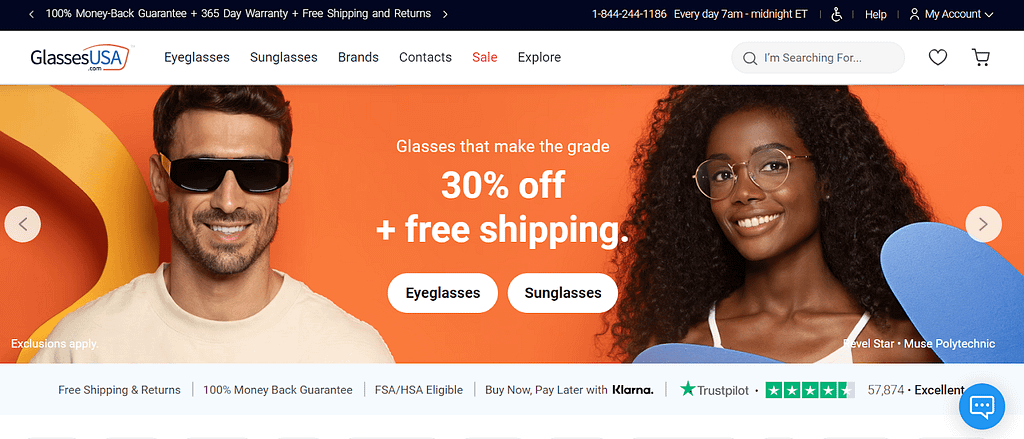
GlassesUSA is an online retailer for prescription eyeglasses, sunglasses, and contact lenses. They offer a wide range of frames and lenses at affordable prices. The marketplace has a virtual try-on feature that allows you to see how the glasses would look on your face before making a purchase.
Zenni Optical
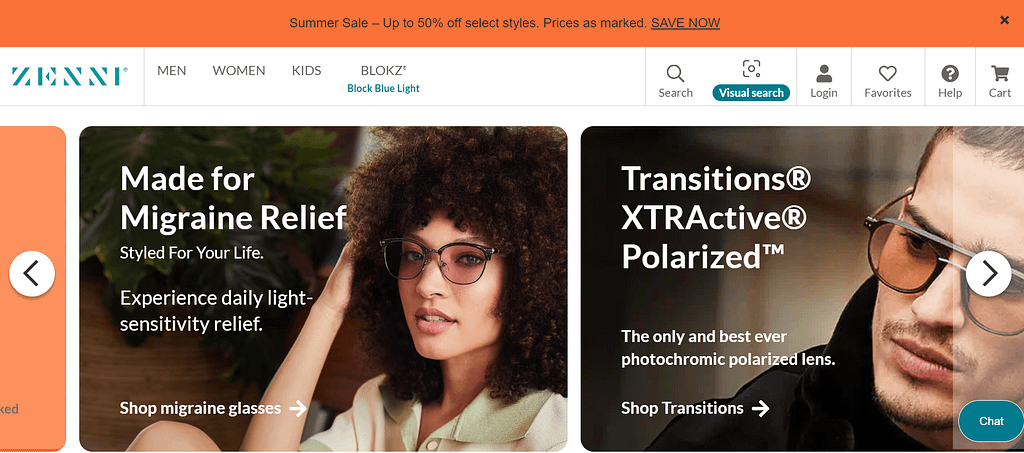
Zenni Optical is an online eyewear retailer that specializes in affordable prescription glasses. They offer a wide selection of frames and lenses, including options for sunglasses and blue light blocking glasses. Zenni Optical is known for their low prices and customizable glasses.
Warby Parker
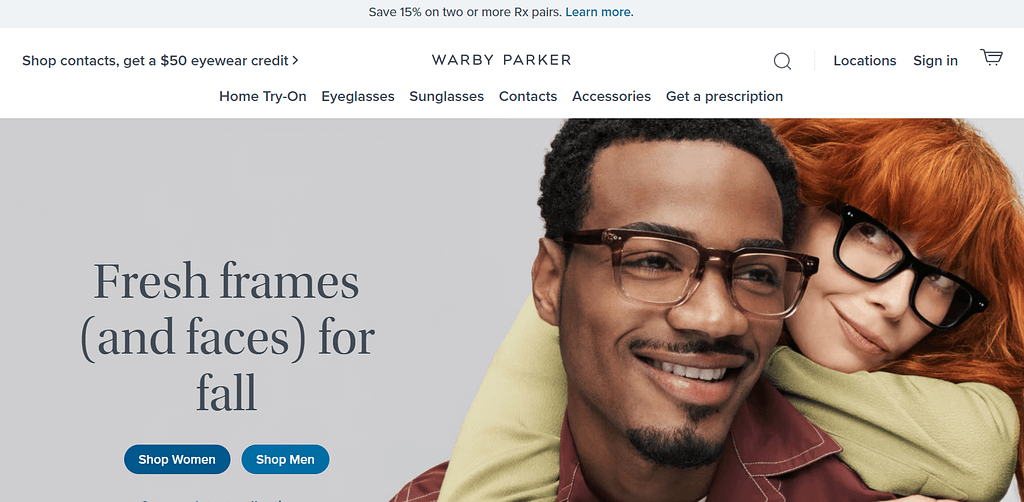
Warby Parker is an eyewear company that sells prescription glasses, sunglasses, and contact lenses both online and in their retail stores. They are known for their stylish frames and affordable prices. Warby Parker also has a “Home Try-On” program where you can select up to five frames to try on at home before making a purchase.
LensCrafters
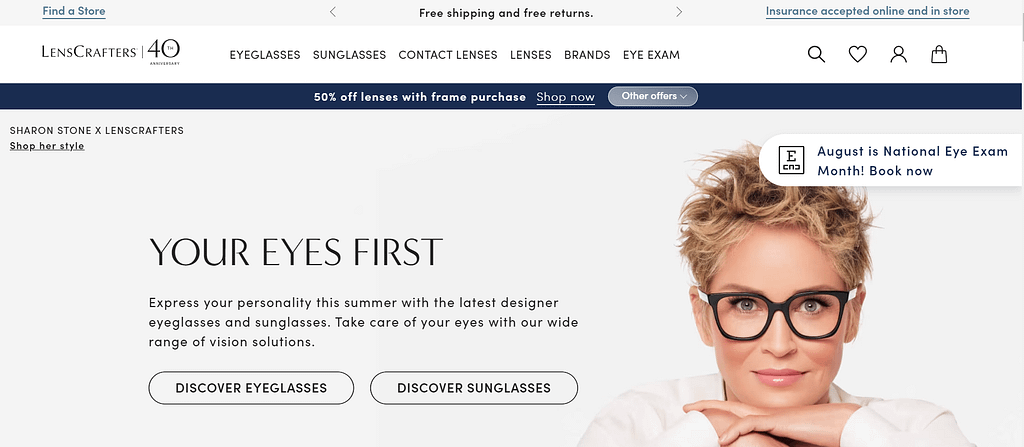
LensCrafters is a well-known eyewear retailer with physical stores across North America. They offer a wide range of eyeglasses, sunglasses, and contact lenses. LensCrafters provides comprehensive eye exams and has an in-house lab for quick lens customization.
EyeBuyDirect
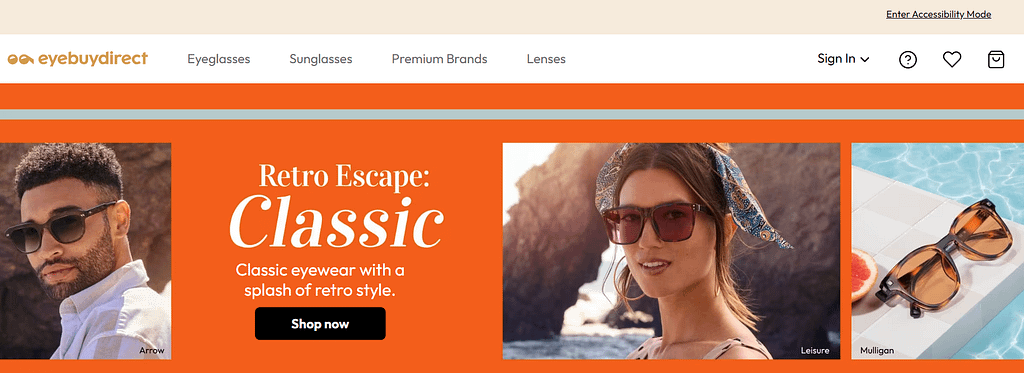
EyeBuyDirect is an online retailer that offers a variety of prescription glasses, sunglasses, and blue light blocking glasses. They provide affordable options and have a virtual try-on feature to help you choose the right frames. EyeBuyDirect also offers a “Home Try-On” program.
FramesDirect
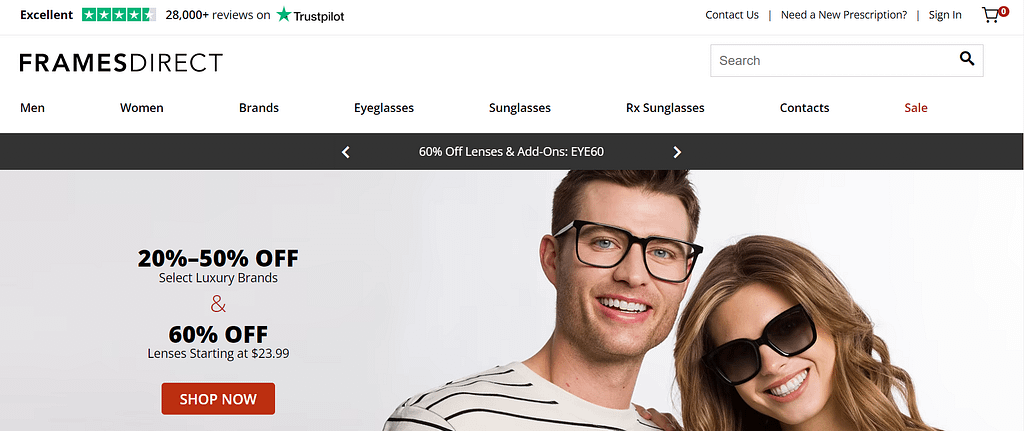
FramesDirect is an online retailer that offers a wide selection of eyeglasses, sunglasses, and contact lenses. They carry various designer brands and provide options for prescription lenses. FramesDirect offers a virtual try-on feature and has a team of certified opticians to assist with any questions or concerns.
Building your own optical marketplace: features and trends to include

The optical marketplace landscape has experienced significant changes with the rise of eCommerce. If you already have a physical optical store, you can supplement it with its digital version. Or, if you’re looking for a niche to start with your online venture, consider online marketplace development from scratch. We summarized the best practices and features you can incorporate into your marketplace concept:
- Many options. Offer a wide range of eyewear options, including prescription glasses, sunglasses, and contact lenses. Provide virtual try-on tools, detailed product descriptions, and customer reviews to help customers make informed decisions. Online optical retailers offer convenience, competitive pricing, and a vast selection of products. Do the same for your future online marketplace.
- Direct-to-Consumer Brands: If you are a Direct-to-consumer (D2C) eyewear brand, then you can sell your items at lower prices compared to traditional retailers. Focus on transparent pricing or offer Price Match Guarantee features to stand out from competitors.
- Online Prescription Glasses: Online retailers now offer the option to purchase prescription glasses online. To do the same, do require customers to provide their prescription details, or offer passing virtual eye exams. Online prescription glasses are often more affordable than those purchased from brick-and-mortar stores, making them an attractive option for cost-conscious consumers.
- Customization and Personalization: Many online optical retailers offer customization options, allowing customers to personalize their eyewear. This includes selecting frame styles, colors, lens options, and even engraving. Customization enhances the shopping experience and allows customers to create unique eyewear that suits their preferences.
- Virtual Try-On Technology: Virtual try-on tools have become increasingly sophisticated, allowing customers to virtually try on different frames using their computer or smartphone. These tools use augmented reality (AR) or artificial intelligence (AI) to provide an accurate representation of how the glasses will look on the customer’s face. Virtual try-on technology helps customers make confident purchasing decisions online.
- Online Eye Exams: Some companies are exploring the possibility of offering online eye exams, allowing customers to get their prescription without visiting a physical optometrist. These online exams typically involve answering a series of questions and performing visual tests using a computer or smartphone. While online eye exams may offer convenience, they are not a substitute for comprehensive eye care and should be used with caution.
To include all of these features, choose a feature-rich platform and a reliable developer who will customize your marketplace to your particular background and requirements.
Our case – See What Happens
Many business owners chose us as their trusted partner to assist them in venturing into eCommerce. That was the case of See What Happens. They operate a glasses’ marketplace that was launched in 2020. We successfully installed the platform for them and implemented numerous customizations to transform the default Multi-Vendor system into a platform that enables customers to effortlessly connect with local opticians without the need to step outside their homes. The site provides a range of services, including locating the nearest optician, allowing users to enter their prescription, facilitating the booking of appointments with local opticians, and even enabling virtual try-ons of glasses.

Look how we implemented Virtual Try-On feature for See What Happens
Conclusion
The future of eyewear is undoubtedly exciting, with technology playing a significant role in enhancing functionality, improving health monitoring, and offering immersive experiences. The growth of ecommerce for opticians further amplifies these advancements, making innovative eyewear solutions more accessible to consumers.

To create a successful marketplace platform for selling glasses, follow these steps:
- Choose an eCommerce platform: Select a suitable eCommerce platform that supports multivendor functionality. Popular options include CS-Cart, Magento, Shopify, or custom-built solutions.
- Install the platform: Install the chosen eCommerce platform on your server or hosting environment. Follow the platform’s documentation or installation instructions for guidance.
- Customize the platform: Tailor the platform to meet the specific requirements of selling glasses as part of an ecommerce solution for opticians. This may involve creating product categories for different types of glasses, adding relevant attributes (e.g., frame material, lens type), adding 3D view of a product, VR functionality, and configuring payment and shipping options.
- Implement multivendor functionality: Enable multivendor functionality on the platform to allow local opticians to list and sell their glasses. This typically involves installing and configuring a multi-seller edition or extension or specific to your chosen eCommerce platform. For example, in CS-Cart, the multivendor feature is provided with the license by default.
- Consider designing and branding: Customize the platform’s design and branding to create a visually appealing and user-friendly marketplace. This may involve creating a unique logo, selecting appropriate colors, and designing a layout that showcases glasses effectively. A user-friendly logo maker can simplify the process, helping you develop a professional brand identity without needing advanced design skills.
- Cater for optician registration and verification: Implement a registration process for opticians to join the marketplace. This process may include verifying their credentials and ensuring they meet certain quality standards, and also creating doctors’ accounts.
- Connect customers with local opticians: Implement features that allow customers to easily connect with local opticians. This could include search functionality based on location, filtering options, and contact forms to inquire about specific glasses or book appointments.
- Test and launch: Thoroughly test the platform to ensure it functions properly and provides a seamless user experience. Once all testing is complete, launch the marketplace and start promoting it to potential customers and opticians.
Remember, the specific implementation details may vary depending on the chosen eCommerce platform and the customizations required. It’s recommended to consult with web developers or experts in eCommerce platforms for more specific guidance and examples tailored to your needs.

